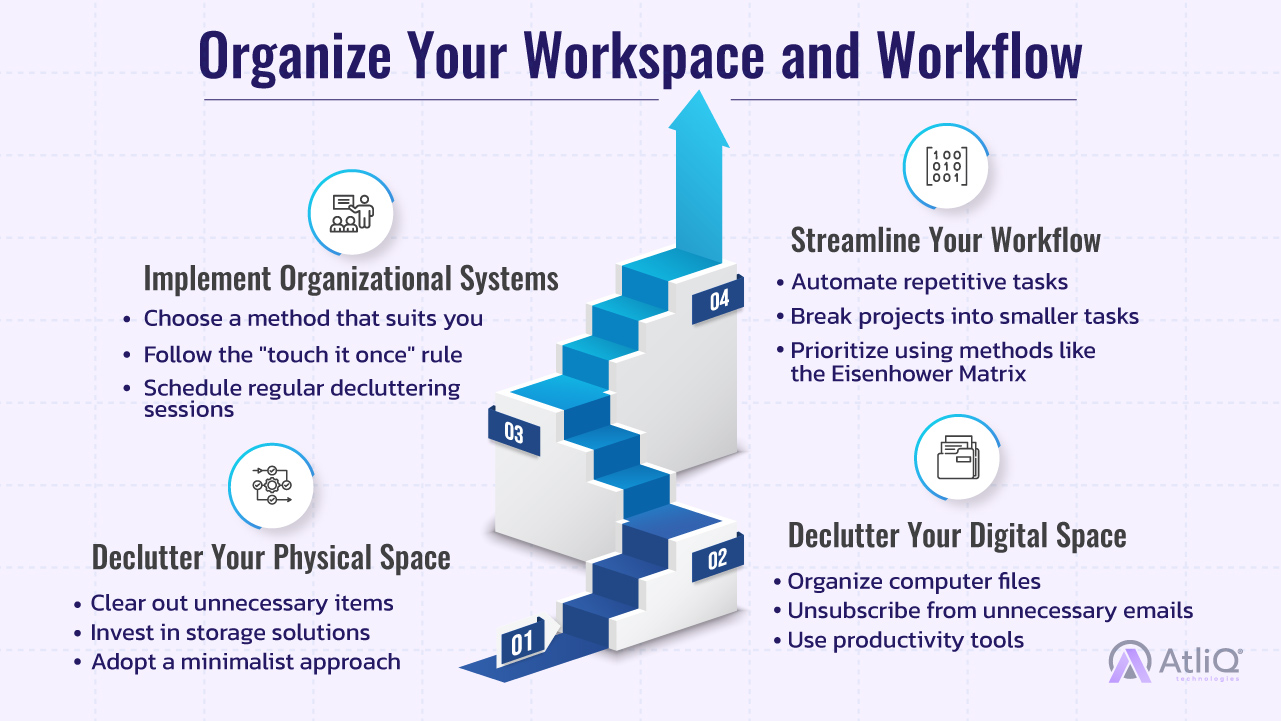
Are you drowning in a sea of tasks, feeling like there aren’t enough hours in the day to get everything done? You’re not alone. In today’s fast-paced world, it’s common to find ourselves buried under a mountain of work, struggling to stay afloat amidst endless to-do lists and deadlines. But fear not! Staying productive, even when your plate is overflowing, is not only possible but achievable with the right mindset and strategies.
Of course, productivity isn’t just about work, work, work. It’s essential to prioritize self-care and downtime. Incorporating exercise, meditation, and other healthy habits into your routine will recharge your batteries and keep you operating at peak performance.
Remember, productivity is a journey, not a destination. It’s about continuously learning and adapting to new challenges. So, embrace a growth mindset, seek feedback, and never stop striving for improvement.
Importance of Prioritization
Imagine you have a dozen tasks vying for your attention, each seemingly as urgent as the next. Without a clear sense of priority, you risk squandering precious time and energy on low-value activities while neglecting those that truly move the needle. Prioritization allows you to focus your efforts where they’ll have the most significant impact, maximizing your productivity and ensuring that you’re working smarter, not harder.
Methods for Prioritizing Tasks
Now that we understand the importance of prioritization, let’s explore some tried-and-true methods for tackling your ever-growing to-do list:
Eisenhower Matrix: Popularized by former U.S. President Dwight D. Eisenhower, this simple yet powerful tool categorizes tasks based on their urgency and importance. Tasks are divided into four quadrants:
- Quadrant 1: Urgent and important
- Quadrant 2: Important but not urgent
- Quadrant 3: Urgent but not important
- Quadrant 4: Neither urgent nor important
By systematically categorizing your tasks, you can focus your attention on the most critical activities while delegating or eliminating those that don’t contribute to your long-term goals.
ABC Method: This method involves assigning each task a priority level based on its significance. Tasks are labeled as follows:
- A Task: High-priority, must-do tasks that directly contribute to your goals.
- B Task: Medium priority tasks that are important but not as urgent as A tasks.
- C Task: Low-priority tasks that can be deferred or delegated.
Time Management Techniques
Time is our most precious resource, yet it often feels like we’re racing against the clock, trying to cram as much as possible into our finite hours. Time management is not about squeezing every last drop of productivity out of your day; it’s about working smarter, not harder. By implementing a few techniques you can maximize your efficiency, minimize distractions, and make the most of every moment. So, take control of your schedule, and watch as your productivity soars to new heights.
- Pomodoro Technique: Named after the Italian word for tomato, this technique involves breaking your workday into focused intervals, typically 25 minutes in length, separated by short breaks. It capitalizes on the principle of timeboxing, helping you maintain focus and productivity by giving your brain regular opportunities to rest and recharge. By working in short, concentrated bursts, you can power through tasks with renewed energy and efficiency.
- Time Blocking: Ever feel like your schedule is a chaotic jumble of conflicting commitments? Time blocking offers a solution by dividing your day into distinct blocks of time dedicated to specific tasks or activities. Whether it’s an hour for email management in the morning or a block of time reserved for creative work in the afternoon, time blocking ensures that you allocate your time intentionally and proactively, rather than reacting to whatever demands come your way. By establishing clear boundaries and routines, you create a sense of structure and predictability that fosters productivity and reduces overwhelm.
- Setting Deadlines: Parkinson’s Law states that work expands to fill the time available for its completion. In other words, without clear deadlines, tasks can drag on indefinitely, consuming more time and energy than necessary. By setting deadlines for yourself and adhering to them rigorously, you create a sense of urgency that drives action and prevents procrastination. Whether it’s a self-imposed deadline for a personal project or a commitment to deliverables for a client or colleague, holding yourself accountable to deadlines ensures that you stay focused and motivated to complete tasks promptly.
- Avoiding Multitasking: Despite its widespread popularity, multitasking is a productivity myth. In reality, attempting to juggle multiple tasks simultaneously only leads to inefficiency, decreased focus, and a higher likelihood of errors. Instead of spreading yourself thin, embrace the power of monotasking – focusing on one task at a time with full concentration and dedication. By giving each task your undivided attention, you can complete it more quickly and to a higher standard, ultimately saving time in the long run.
Learn to Delegate
Delegation is a skill that can significantly enhance productivity and efficiency, yet it’s often underutilized or misunderstood. Far from simply offloading tasks onto others, effective delegation involves a strategic approach to task distribution that empowers team members, frees up valuable time for leaders, and ultimately drives better results.
Recognizing when to delegate is the first step toward mastering this skill. It’s about understanding that not every task requires your attention or expertise. Once you’ve identified tasks to delegate, the next step is to delegate effectively. This means communicating expectations, deadlines, and desired outcomes to those you’re entrusting with the tasks. Effective delegation also involves trusting your team members to work autonomously and make decisions within their delegated responsibilities while remaining available for guidance and assistance when needed.
In essence, learning to delegate is about more than just lightening your workload; it’s about cultivating a culture of collaboration, trust, and empowerment within your team. By recognizing when to delegate, effectively assigning tasks, and trusting others with responsibilities, you can unlock your team’s full potential and achieve greater success together. So, embrace delegation as a strategic tool for maximizing productivity and driving meaningful outcomes.
Practice Self-Care
Self-care encompasses a wide range of activities, from exercise and healthy eating to mindfulness and relaxation techniques. Taking breaks, getting enough sleep, and engaging in activities that bring you joy are all essential components of self-care. By making self-care a priority, you can recharge your batteries, reduce stress, and improve your overall well-being. Incorporating self-care into your daily routine doesn’t have to be time-consuming or complicated. Even small, simple acts of self-care can make a big difference in how you feel and function. Whether it’s taking a short walk outside, practicing deep breathing exercises, or spending time with loved ones, find what works for you and make it a regular part of your routine.
Remember, self-care isn’t selfish – it’s essential. By taking care of yourself, you’re better equipped to handle the demands of daily life, stay focused, and perform at your best. So, don’t forget to prioritize self-care amidst the chaos of your busy schedule. Your mind, body, and spirit will thank you for it.
Continuous Learning and Improvement
Continuous learning and improvement are the cornerstones of personal and professional growth. In today’s fast-paced world, staying stagnant is not an option. Instead, embracing a mindset of lifelong learning can open doors to new opportunities and enhance your skills and knowledge.
Seeking feedback and actively soliciting ways to improve is essential for growth. Whether it’s from colleagues, mentors, or clients, feedback provides valuable insights into areas where you can enhance your performance and refine your skills. Embrace feedback as a gift and use it as a catalyst for growth. Whether through formal education, workshops, or online courses, dedicating time and resources to learning new skills and expanding your knowledge base can position you for success in an ever-evolving job market.
Embracing a growth mindset is crucial for continuous improvement. Instead of viewing challenges as roadblocks, see them as opportunities for growth and learning. Adopting a mindset of curiosity and resilience will enable you to adapt to new situations, overcome obstacles, and continuously improve yourself and your work.
As we reach the end of our productivity journey, let’s take a moment to reflect on the incredible power we hold within our grasp. Like alchemists of old, we’ve transformed the chaos of overwhelming workloads into the gold of productivity and efficiency.
But our quest for productivity is not a destination; it’s a lifelong odyssey. It’s about embracing the ebb and flow of productivity, adapting to new challenges, and continuously striving for improvement.
So, as you navigate the choppy waters of your daily tasks, remember this: you are the captain of your productivity ship. With the right tools, strategies, and mindset, you can steer through even the stormiest seas of work with confidence and grace.
Bon voyage, fellow productivity warriors!
